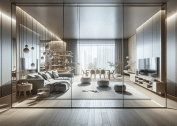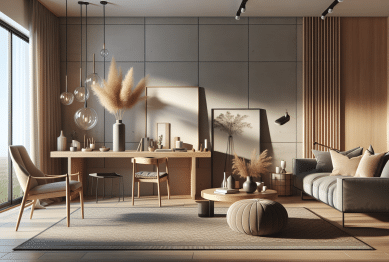Explore how minimalist home design transforms living spaces with simplicity, style, and comfort. This guide uncovers practical secrets for decluttering, selecting neutral palettes, furniture choices, and maximizing light to create a serene environment. Discover what makes this approach so appealing and sustainable for modern living.
The Basics of Minimalist Home Design
Minimalist home design stands out for its purposeful simplicity. Everything in a minimalist space serves a function or intentionally creates calm. Instead of crowding rooms with furniture, minimalist interiors prioritize open floor plans, gentle color schemes, and clean lines. This approach reduces visual noise, making spaces more peaceful and inviting. Many people find their stress reduced simply by adopting a minimalistic layout at home.
One of the most attractive elements is the neutral palette often seen in minimalist homes. Whites, grays, beiges, and muted tones encourage relaxation and adapt well to different décor accents. This doesn’t have to mean cold or boring; with the right textures and accents, minimalist designs can feel warm and lively. By eliminating the unnecessary, rooms begin to breathe—becoming easier to maintain while looking “effortlessly organized.”
At the heart of the minimalist movement is intentional living. Each possession has a purpose, every design element is carefully chosen. This mindset helps homeowners develop a deeper appreciation for quality over quantity. It’s not just about paring down but thoughtfully curating belongings. Many discover that as their surroundings simplify, daily routines become more efficient, and home becomes a true retreat from clutter and stress.
Decluttering: The Foundation of Minimalism
Decluttering is the most crucial first step in minimalist home design. It’s more than tidying up—it’s about examining each item for value and utility. Start by focusing on visible surfaces: countertops, tables, open shelves. Removing excess lets key features and favorite pieces shine. Incremental progress is powerful. Tackling one category or room at a time prevents overwhelm and makes it easier to maintain momentum.
Many experts recommend the ‘one in, one out’ rule. For every new item brought into the home, another is let go. Digital decluttering is just as important. Clean out email folders, delete unnecessary files, and minimize digital distractions. There’s a growing recognition that organizing virtual life helps clear mental clutter, freeing up attention for creativity and relaxation. A minimalist approach applies online as well as offline.
Some individuals rely on professional organizers or minimalism coaches, but a do-it-yourself approach works for many. Donation, recycling, and responsible disposal ensure that released items don’t add to waste. Charitable organizations often welcome furniture, kitchenware, and clothing, letting your decluttering have a positive community impact. The emotional freedom gained from letting go of excess can be transformative, supporting mental and emotional well-being. (Source: https://www.psychologytoday.com/us/blog/the-moment-youth/202206/the-benefits-decluttering)
Choosing Minimalist Furniture and Decor
The right furniture is essential in minimalist home décor. Look for pieces that are timeless, functional, and built to last. Sofas with clean silhouettes, unadorned wooden tables, and modular storage units create elegant, versatile spaces. Scale is also key—oversized furniture can overwhelm small rooms, while streamlined pieces make even compact homes feel spacious. Quality is emphasized over quantity; investing in fewer, better furnishings pays off over time.
Decor in minimalist homes follows the ‘less but better’ philosophy. Select a few art pieces, plants, or personal objects that carry meaning or beauty. A sculptural vase, a single large-scale painting, or a cluster of succulents can become stunning focal points. Neutral tones dominate, but pops of color or lush green from houseplants prevent monotony. Even minimalist homes benefit from texture—think linen, jute, or unfinished wood—to add warmth and tactility.
Smart storage solutions are a minimalist’s best friend. Hidden compartments, under-bed drawers, and wall-mounted shelves keep items accessible but out of sight. These choices prevent unnecessary clutter while making cleanup a breeze. Flexible, multi-purpose pieces—like ottomans with storage, nesting tables, or convertible seating—maximize function in smaller living areas. Effective use of furniture and decor ensures that open spaces remain a visual hallmark of the minimalist aesthetic. (Source: https://www.apartmenttherapy.com/minimalist-home-decor-268267)
Harnessing Light and Space in Minimalist Interiors
Light is a central feature in minimalist interiors. Natural light emphasizes openness and makes rooms appear larger. Large windows, glass doors, and strategically placed mirrors amplify sunlight. Where privacy is needed, sheers or blinds filter rays while preserving soft illumination. This thoughtful use of daylight reduces energy needs and boosts the mood, further enhancing the calming atmosphere that defines minimalist home design.
Artificial lighting gets equal attention. Minimalist homes favor discreet recessed lighting, sleek pendant lamps, or unobtrusive wall sconces. Layered lighting is the secret to adapting spaces for reading, working, or relaxing. Smart lighting systems let residents control brightness and color temperature, tailoring environments to the time of day or activity. Successful minimalism isn’t about starkness; it relies on intentional, adaptable use of space and light.
Open floor plans are a key concept. Removing physical and visual barriers between zones (like kitchen, living, and dining areas) supports easier movement and flexibility. If walls can’t be removed, using rugs and lighting to demarcate spaces offers a simple fix. Minimalism doesn’t ignore comfort; it reimagines luxury as understated spaciousness, where every corner feels curated and every function is considered. (Source: https://www.housebeautiful.com/room-decorating/living-family-rooms/g29836381/minimalist-living-room-ideas/)
Sustainability and Well-Being in Minimalist Living
Minimalism naturally encourages sustainable living. Choosing fewer, higher-quality items reduces consumption and waste. Many minimalist homes favor eco-friendly materials like reclaimed wood, organic textiles, or recycled furnishings. This commitment to sustainability isn’t just environmental. It creates healthier indoor air, avoids harsh chemicals, and supports ethical brands. More people are realizing that sustainability and minimalism go hand in hand, making long-term lifestyle shifts feel rewarding rather than restrictive.
Minimalist living also supports well-being. Studies show that cluttered spaces can increase stress levels and sap motivation. By streamlining surroundings, residents often enjoy improved focus, productivity, and mood. Minimalist design encourages regular habits of maintenance, leading to cleaner, safer living conditions. Approaching life with a minimalist mindset—choosing experiences over possessions, quality over novelty—boosts life satisfaction and eases anxiety.
Communities and families benefit, too. Minimalism can foster better family communication, since shared spaces are tidy and distractions are reduced. Social gatherings feel more relaxed and welcoming with uncluttered entertaining zones. While minimalist design is often seen as an aesthetic, its real impact is holistic. It helps people unwind, reconnect, and find contentment with less. (Source: https://www.nbcnews.com/better/lifestyle/why-minimalist-lifestyle-good-your-health-ncna747451)
Personalizing Your Minimalist Space
Minimalism isn’t a one-size-fits-all formula. There’s room for personal tastes within the minimalist framework. Integrate family treasures, photos, or artwork with intention. Many find that by reducing clutter, meaningful possessions take on new significance. It’s the story behind the object, not the number of items, that adds richness to a home. Individuality is celebrated through careful selection and thoughtful placement.
Don’t ignore comfort. Layer soft pillows, thick throws, or a favorite armchair for coziness. Plants and flowers add natural energy and color. Minimalist homes shine when they reflect the personalities of their inhabitants—be it through travel souvenirs, handmade ceramics, or legacy heirlooms. The goal is harmony: a balance between calm order and personal joy.
Continue evolving your minimalist home as your life and needs change. Minimalism is a process, not a fixed outcome. Periodically reassess what you own and why. Experiment with new layouts or textures. By making intentional updates, minimalist interiors stay fresh, meaningful, and inspiring. Your space can tell your story—simply, beautifully, and with unmistakable authenticity. (Source: https://www.verywellmind.com/how-to-become-a-minimalist-5187285)
References
1. Smith, J. (2022). The benefits of decluttering. Retrieved from https://www.psychologytoday.com/us/blog/the-moment-youth/202206/the-benefits-decluttering
2. Apartment Therapy. (2021). Minimalist home decor ideas. Retrieved from https://www.apartmenttherapy.com/minimalist-home-decor-268267
3. House Beautiful. (2020). Minimalist living room ideas. Retrieved from https://www.housebeautiful.com/room-decorating/living-family-rooms/g29836381/minimalist-living-room-ideas/
4. NBC News. (2018). Why a minimalist lifestyle is good for your health. Retrieved from https://www.nbcnews.com/better/lifestyle/why-minimalist-lifestyle-good-your-health-ncna747451
5. James, S. (2022). Minimalism and sustainability. Retrieved from https://www.archdaily.com/908628/how-minimalism-can-help-create-a-sustainable-future
6. Verywell Mind. (2021). How to become a minimalist. Retrieved from https://www.verywellmind.com/how-to-become-a-minimalist-5187285









